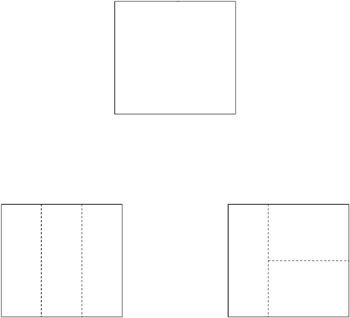As Easy as Pie
As Easy as Pie 
If you’ve ever asked a young child to cut a pie for several people, the child will likely cut a piece for himself or herself and then pass you the knife. Perpendicular cuts across the length of the pie come naturally to adults for the sake of overall efficiency. Young children simply find this to be too altruistic. This puzzle is an attempt to help you recapture that inner child.
You will design a series of cuts to partition a square pie into equal pieces to share among several people. The piece finally offered to each person is called a “final piece.” Here are the rules:
-
All cuts must be straight, vertical, and parallel to one of the original sides.
-
All final pieces must contain the same amount of pie volume (and, because of the first rule) the same amount of the top of the pie.
-
(Child cut rule) Every cut should yield one final piece except the last one, which yields two final pieces.
The goal, which admittedly might occur only to a lazy, clever, or lazy and clever child, is to minimize the sum of the perimeters of all the final pieces.
Warm-Up
We start with the square pie in Figure 1-8.

Figure 1-8: Two possible ways of cutting the original pie (above) into three pieces of equal size. The bottom left shows two parallel cuts. The bottom right shows two perpendicular cuts.
We could cut that square pie using two parallel cuts (A) or using two perpendicular cuts. Both satisfy the three rules: equal size final pieces, vertical cuts, and child cut rule. Which yields a smaller total perimeter?
Solution to Warm-Up
In the parallel cut case (A), each final piece has a perimeter of length 1 + 1/3 + 1 + 1/3 = 8/3. So the three final pieces altogether have a total perimeter of 8. Two perpendicular cuts (B) yield a first final piece having perimeter 8/3 and the remaining two final pieces each having perimeter: 2/3 + 1/2 + 2/3 + 1/2 = 7/3. In this case, the total perimeter is 7 1/3.
Now it’s your turn.
-
Find a cut design obeying the above three rules that minimizes the total length of the perimeters for five pieces.
For the remaining questions, let’s pretend we’re working with adults. So, we drop the child cut rule, but keep the first two.
-
How much better can you do for five pieces, after dropping the child cut rule?
-
What about nine pieces?
| Hint: | There is a Russian doll feeling about this one. |
-
Can you get a smaller perimeter for five pieces, if, in addition to dropping the child cut rule, you drop the rule that cuts must be parallel to the original sides?
Try this puzzle on a smart child sometime. Enjoy the reaction you get. In my experience, someone always ends up laughing.
EAN: 2147483647
Pages: 81